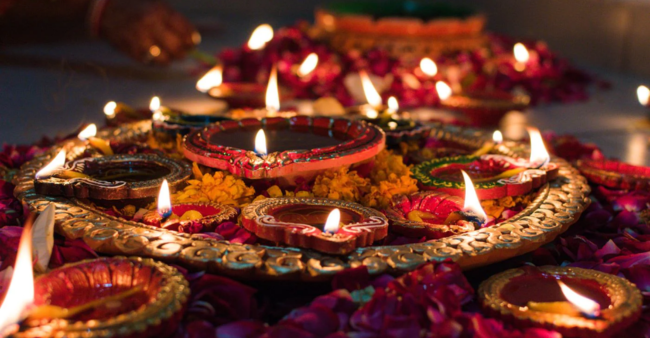While the ways of celebrating Diwali may differ, but the essence of the festival remains the same, the spreading of light and love.
Sabhi Ke deep sundar hai, hamafe kya tumahre kya
Ujaala har taraf hai, is kinare us kinare kya
The couplet by Hafeez Banarasi explains the essence of Diwali in India. India is not just known for its myriad languages, landscapes, and traditions, but also for the multitude of ways in which it celebrates Diwali, the most anticipated and cherished celebration in the country. Diwali in India is not only the celebration of lord Ram’s return from exile but is also a festival of joy for the entire Indian psyche and its observance varies significantly across different regions and cultures. This festival is a way of celebrating homecoming and welcoming prosperity and wellness. While the ways of celebrating may differ, the essence of Diwali remains the same—the spreading of light and love. This tapestry of cultures is a testament to India’s unity in diversity and the beauty of celebrating traditions that are as old as time itself. It is also the time when in a community where agriculture has long ruled, a farmer’s face lights up when the harvest arrives at the end of a long year of labour. He seizes the chance to make his family happy. Typically, Diwali is a five-day celebration with distinct rites held each day, with the major ceremony taking place on the third day. It’s observed 20 days following Dussehra. In northern India, particularly in the Hindi heartland, Diwali commemorates Lord Rama’s return to Ayodhya after defeating the demon king Ravana. The festival is celebrated with grand processions, melodious bhajans, and the lighting of earthen lamps. In West Bengal and the eastern states, Diwali coincides with the worship of Goddess Kali. Known as “Kali Puja”, it is marked by fierce rituals and the lighting of lamps, signifying the victory of light over darkness. The festival holds a special place in the hearts of Bengalis, and homes and temples are adorned with intricate alpana designs. In Gujarat, Diwali coincides with the Gujarati New Year, and it’s celebrated with great fervour. The streets and homes come alive with colourful decorations, and people participate in the age-old tradition of Garba and Dandiya dances. The lighting of lamps and bursting of firecrackers signify the victory of light over darkness. In the northeastern states, Diwali serves as a community bonding experience. The lighting of lamps, cultural programs, and shared meals bring people together. Traditional dances, like Bihu in Assam, add a vibrant and festive touch to the celebrations. In Jammu and Kashmir, Diwali has a special significance for the Kashmiri Pandit community. It symbolizes their homecoming and the rekindling of hope. The lighting of lamps and prayers at temples are central to their observance.
Though Diwali preparations begin with Ram Navami and Dussehra, real festivities begin from Dhanteras, also known as Dhanvantari Trayodashi, which is on the 13th day of the dark fortnight of Kartik—this marks the beginning of Diwali. Along with the rituals of Lakshmi Puja and buying new items, Dhanteras is also the birthday of Lord Dhanvantari, the founder of Ayurveda and the god of medicine. According to the scriptures, during the churning of the ocean, on the day of Trayodashi, the nectar pot was obtained from that churning. Lord Dhanvantari appeared with the nectar pot. That is why it is considered a symbol of good health
Naraka Chaturdashi in the west and south, and Bhoot Chaturdashi in the east. There are many stories behind it. According to one belief, on this day Lord Krishna killed the demon Narakasura and freed thousands of imprisoned women. After the liberation of the women, the tradition of celebrating Narak Chaturdashi started every year on the day. According to the Skanda Purana, Suryadev had two children, Yamraj and Yamuna. Yama used to punish sinners. Yamuna was saddened by her brother’s actions. She wanted to call Yama home and pray for his long life. After a long effort, Yama reached his sister’s house on Kartik Shukla’s Dwitiya. The sister welcomed the brother warmly and fed him with Annakoot. Seeing Yamuna’s love and affection towards him, Yama asked her to ask for a boon. Yamuna said that whoever goes to the house of a sister and accepts hospitality on the Dwitiya of Kartik Shukla, all his sins will be destroyed and he will live a long life. Yama disappeared after saying “tathastu”, and since then the tradition of Bhai Dooj has been celebrated to mark the day.
Next comes Govardhan puja. According to legend, Lord Krishna learned that the people of Braj were getting ready to worship Lord Indra, who on being happy with this adoration sent rain. Krishna recognized Lord Indra’s arrogance and advised the people to rather worship Govardhan than Indradev since it is he who gives our cows green manure. Upon learning of this, Indra unleashed torrential rain. Krishna lifted Govardhan mountain for the people of Braj and kept the people safe for seven days. Finally, Indra apologised to Shri Krishna. Since then the tradition of Govardhan Puja has been going on.
India, often referred to as the “Land of Festivals”, thrives on cultural dynamism. The kaleidoscope of Indian culture is a testament to its diversity and the rich tapestry of festivities that adorn its calendar. The cultural dynamism of India is a symphony of traditions, rituals, and celebrations that have been passed down through generations, evolving and adapting while retaining their deep-rooted significance.
India’s cultural dynamism is deeply intertwined with its religious and spiritual diversity. These religious festivals not only serve as occasions for worship and reflection but also as opportunities for communities to come together, share, and express their faith.
Anurag Punetha is the Media Head, IGNCA, Ministry of Culture.

